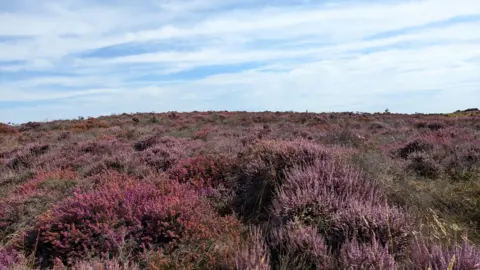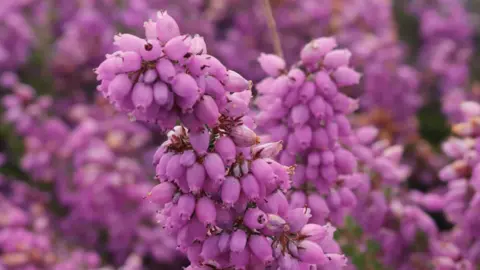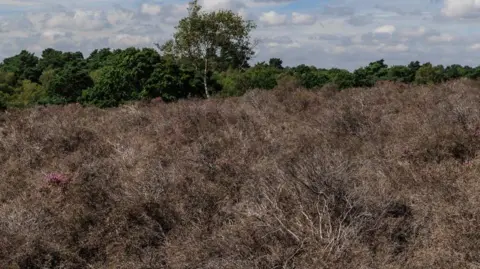Heather blooms again after a welcome wet spell
 National Trust
National TrustHeather severely damaged by extreme heat and drought two years ago is recovering following a wet start to the year.
The rare heathland habitat at Dunwich Heath, Suffolk, is showing signs of "remarkable" improvement this summer.
But the National Trust warned that it is "experiencing first-hand the consequences of more frequent extreme weather events", and it called for the government "to address this significant issue".
The conservation charity said drone surveys carried out last summer confirmed a 60% loss in heather at Dunwich Heath, but similar surveys in June indicated 11% of the damaged heather had sprung back to life following increased February rainfall.
The rare heathland habitat of Dunwich Heath is nationally important and is home to species including nightjar, woodlark and adders.
Three types of heather typically grow and flower there from June to September – common, bell and cross-leaved – transforming the landscape into a bright and vibrant patchwork.
 National Trust
National TrustBut hotter, drier summers are pushing the limits of what the heather can cope with, and the 2022 drought in the middle of the flowering season caused almost the entire heath to fail to flower, with some plants dying.
Where there was significant die-off in the heather, there were also fewer insects, particularly pollinators, which provide crucial food for nesting birds.
Resident species such as the Dartford warbler depend on reliable food sources year-round, with numbers dropping from 30 breeding pairs to fewer than 20 from 2022 to 2023.
However, rangers believe the wettest February on record in East Anglia has contributed to encouraging signs of recovery for the heather this year.
Sam Cooper, National Trust area ranger at Dunwich Heath, said: "Results from the recent drone survey have confirmed that just over half of the heathland is now made up of live heather.
"This time last summer, it was down to 40%, so it's really encouraging.
"The wet start to the year has certainly helped, and we'll be continuing to monitor how the weather impacts not just the heather itself but the birds and other wildlife that depend on it."
 National Trust
National TrustBen McCarthy, head of nature conservation and restoration ecology at the National Trust, said: "As the UK's largest conservation charity we are experiencing first-hand the consequences of more frequent extreme weather events, such as the prolonged period of drought that severely impacted the heath at Dunwich.
"Many rare wildlife and plant species rely on this and other habitats threatened by our changing climate.
"This is why one of our priority asks for the new government is to address this significant issue to help ensure generations for years to come can enjoy the nature, beauty and history of this country, and sights such as carpets of purple heather are not lost."
Follow Suffolk news on Facebook, Instagram and X. Got a story? Email [email protected] or WhatsApp us on 0800 169 1830
